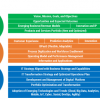Business Transformation Requires Transformational Leaders
Leadership and teaming skills are front and center in times of rapid change. Meet today’s constant disruption head on with expert guidance in leadership, business strategy, transformation, and innovation. Whether the disruption du jour is a digitally-driven upending of traditional business models, the pandemic-driven end to business as usual, or the change-driven challenge of staffing that meets your transformation plans — you’ll be prepared with cutting edge techniques and expert knowledge that enable strategic leadership.
Subscribe to Arthur D. Little's Culture & Leadership Newsletter
Insight
The business environment is changing at a faster rate than ever before. One of the drivers of change is clearly technology, which is disrupting business at multiple levels. Within the organization, technology is disrupting business processes and the roles people play. Outside the organization, technology is enabling new business models, leading to new forms of competition. Today’s customers have much more access to technology and devices, and they expect to use those to interact with businesses. They also expect businesses to offer more sophisticated, smarter products and services tailored to their needs and preferences.
In this article, I discuss key drivers for adoption of digital business, propose a framework organizations can use to guide their digital transformation efforts, and consider the value digital transformation is delivering in areas of healthcare, travel, and government.
This article examines the impact of digital technologies, including virtual reality (VR), on the sharing and archiving of life events and explores the potential business opportunities that are apt to arise from these technologies. It also seeks to illustrate, through exploring the impact of disruptive technologies on the photographic industry, the lessons to be drawn when either tackling the technological challenges in a long-established traditional business or seeking to create a new market opportunity enabled by disruptive technologies.
Toward Collaborative Leadership
As an executive coach, I continuously hear new clients say, "All I want are results. Is it too much to expect people to deliver on their commitments?" After a few minutes of additional dialogue, we typically discover several organizational, technical, and managerial challenges that have culminated in some noticeable and negative result. In other words, I'm being asked to fix a problem that has escalated to a level that is no longer tolerable to those in leadership.
This is the first in a series of three Advisors on poorly managed and executed government IT systems and their effects on citizens.
Business people judge services by making sense of what they experience relative to their needs. Most business decisions about IT are, and will continue to be, made in this way. This is in contrast to the current IT delivery model and the product-centric process of “define, build, and operate,” which will become less relevant as future technology and increased complexity make defining and testing product requirements difficult, if not impossible, except at runtime.
Exploring New Ground in the Digital Society
When everything connects to everything and new value systems emerge, a number of things will start to accelerate disruption in society: the speed of change, the growth of data, and the number of innovations. For businesses, traditional models may suddenly be swept away by disruption, but this disruption can also introduce new opportunities. The proliferation of technology and the new value systems that emerge from it are driving changes in business strategies and IT strategies. A new style of IT has come to the forefront, and it is becoming one of the main drivers of change.
In this on-demand webinar, you'll discover how a shift in perspective and reassertion of some key principles of EVM can make it a successful tool for managing performance on Agile projects.

















